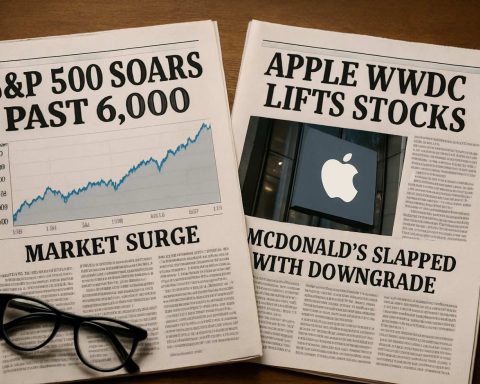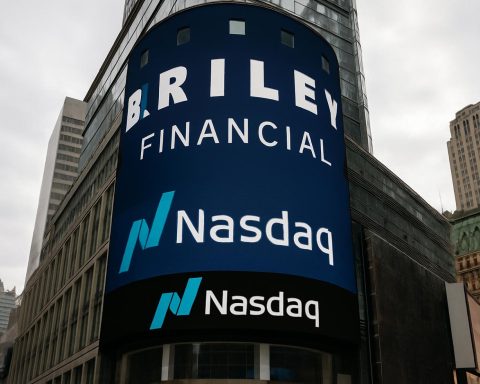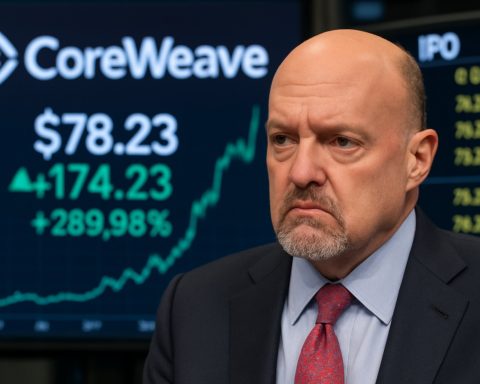- 2025 unveils a volatile market, with big-cap stocks grappling with declines amid economic uncertainty.
- KKR & Co. Inc. announced a $2.25 billion offering in mandatory convertible preferred stock, raising concerns over potential funding struggles.
- KKR exceeded earnings expectations with a $1.32 EPS and $3.3 billion in revenue but faced a 26.4% drop in adjusted revenue due to high insurance expenses.
- KKR shares fell 18.24% year-to-date, despite a market consensus price target suggesting a 35% upside.
- The S&P 500 reversed its growth trend, declining 1.5% year-to-date, influenced by tariffs and AI-related concerns.
- The current market environment presents opportunities for investors focusing on long-term resilience and potential turnarounds.
- 2025 reinforces the importance of patience and strategic foresight for navigating turbulent financial landscapes.
As the sun rises on a turbulent 2025, investors find themselves staring down a market dense with uncertainty and volatility. The financial winds have shifted dramatically, foreshadowing a year where big-cap stocks, once the vanguards of growth, now grapple with daunting declines.
KKR & Co. Inc., a titan of investment known for its strategic prowess, has experienced a significant downturn, a tale that unravels across the determined lines of trading graphs. This year, the firm boldly announced a massive $2.25 billion offering in mandatory convertible preferred stock with a 6.25% dividend rate. While it may bolster long-term financing, the maneuver has raised eyebrows among shareholders, signaling potential funding struggles and casting a shadow over KKR’s sheen.
Despite this turmoil, KKR managed to surpass earnings expectations, boasting an adjusted EPS of $1.32 alongside a robust $3.3 billion in revenue. However, the triumph is marred by a 26.4% drop in adjusted revenue, predominantly due to soaring insurance expenses, underscoring the complex layers of financial performance. Astonishingly, even as analysts pin the consensus price target at $161.43—implying a generous 35% upside—the firm’s shares have tumbled 18.24% year-to-date, leaving investors in a state of contemplation.
Meanwhile, the broader market has not remained unscathed. The S&P 500, a barometer of financial health, has reversed its sparkling growth streak from prior years, dipping by 1.5% year-to-date. Historical patterns suggest that such remarkable annual gains are often followed by a sobering correction period. But the rapid decline of these heavyweights invites more complex questions, especially as tariffs and AI-related anxieties rattled investor confidence.
KKR’s tale is a multifaceted narrative, woven into the broader tapestry of a market recalibrating its pace after a dizzying ascent. The allure of AI and the digital sphere, once harbingers of boundless potential, now seems dimmed as market forces gravitate towards reevaluation. Yet, beneath this plight, lurks opportunity; firms beaten down by market sentiments become attractive prospects for discerning investors eyeing resilient comebacks or hidden gems.
Perhaps the narrative holds a lesson in patience and strategic foresight—hallmarks of any seasoned investor navigating the world’s tumultuous financial seas. While 2025 unfolds its script of financial surprises and recalibrations, astute market watchers may find solace or fortune in identifying the silver lining—the promising undercurrents hiding within the paradox of an otherwise turbulent market.
Navigating the Choppy Waters of 2025: Investment Strategies for Uncertain Markets
Market Overview and Key Insights
As we step into 2025, the financial landscape has undergone a seismic shift. Big-cap stocks, traditionally seen as pillars of growth, are experiencing notable declines. The focus is now on strategic maneuvering through these chaotic market conditions.
KKR & Co. Inc. stands as a focal point of this turmoil, having recently announced a $2.25 billion offering in mandatory convertible preferred stock with a 6.25% dividend rate. While this move intends to shore up long-term financing, it also suggests possible liquidity issues, raising concerns amongst investors. Despite this, KKR exceeded earnings forecasts with an adjusted EPS of $1.32 and revenue of $3.3 billion. Yet, a 26.4% drop in adjusted revenue, largely due to rising insurance costs, signals underlying challenges.
Simultaneously, the S&P 500 has dipped by 1.5% year-to-date, reflecting widespread jitters exacerbated by tariffs and AI concerns. Historically, significant growth is often followed by corrections, hinting at broader market recalibration.
Understanding the Current Trends
1. The Shift from Growth Stocks: Investors are moving away from big-cap stocks towards more secure, value-oriented investments.
2. AI Anxiety: While once considered the ultimate growth area, the AI sector is undergoing scrutiny, with market participants wary of overvaluation and regulatory hurdles.
3. Insurance and Inflation Pressures: These factors are squeezing margins across industries, as seen in the significant expenses faced by firms like KKR.
4. Global Tariff Concerns: Ongoing geopolitical tensions and trade tariffs are stoking fears of economic slowdowns.
Strategic Investment Approaches
1. Diversification Across Sectors: Instead of concentrating on big-cap growth stocks, consider diversifying into value stocks, bonds, and commodities to hedge against volatility.
2. Exploring Underpriced Opportunities: Firms that are undervalued due to market sentiment might represent growth opportunities. Assess financial fundamentals carefully before investing.
3. Defensive Stocks: Consider stocks in essential sectors like healthcare and utilities which typically perform well during downturns.
How-to-Guide for Investors
1. Conduct Thorough Research: Use analytical tools to evaluate the true financial health of companies, especially those with recent stock tumbles.
2. Stay Informed on Global Developments: Economic policies and international relations can impact market dynamics significantly.
3. Utilize Financial Advisors: Leverage expert insights to guide investment decisions during periods of extreme market uncertainty.
Real-World Use Cases
– Diversifying Portfolios: For instance, shifting some investments from tech-heavy funds to those with a mix of consumer staples can provide balance.
– Utilizing AI: Despite current concerns, AI integration for portfolio analysis can offer additional insights into market trends.
Market Predictions
Industry analysts suggest that after this period of correction, there could be a stabilization as markets adapt to new normals, such as emerging market forces and stabilized trade policies.
Final Recommendations
– Exercise Patience and Strategic Foresight: Investing in a volatile market requires careful planning and a long-term view.
– Explore Educational Resources: Stay updated on market trends through credible financial courses or platforms.
For continuous updates about market trends and investment strategies, visit Forbes.
Remember, successful investing in uncertain times hinges on robust research, strategic diversification, and a patient mindset. Happy investing!










